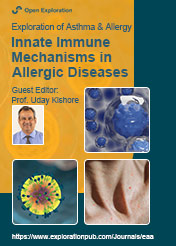
Innate Immune Mechanisms in Allergic Diseases
Guest Editors
Prof. Uday Kishore E-Mail
Universities of Oxford, Brunel and UAEU, London, England
Research Keywords: Innate immunity, complement, pregnancy, cancer, allergy, rhinitis, ABPA, immunotherapy, biologics
Dr. Ahmad Al Aiyan E-Mail
Department of Veterinary Medicine (CAVM), United Arab Emirates University, Al Ain, UAE
Dr. Ann Mary Joseph E-Mail
Department of Veterinary Medicine (CAVM), United Arab Emirates University, Al Ain, UAE
About the Special lssue
The innate immune system, being the first line of host defence, responds quickly following the invasion by microorganisms or any foreign substances via its cellular and humoral repertoire that recognizes unique non-self molecular patterns. This recognition leads to a range of effector mechanisms, including activation of signaling pathways, thereby linking it to adaptive immunity. A number of pathogenic as well as protective mechanisms involving allergic diseases (and other hypersensitivity reactions) are reliant on innate immunity. This is an area of intense research currently in the field of allergy and clinical immunology. New insights into the role of innate immunity in understanding allergic disorders are required.
Innate immune system is the first line of host defence, where innate immune cells, especially dendritic cells (DC), eosinophils, and mast cells, trigger pro-inflammatory responses for the elimination of foreign substances. Yet another feature of the innate immune system is the highly specialised germline-encoded receptors that differentiate between self and non-self by membrane-bound and cytoplasmic pattern recognition receptors (PRRs). This includes an important role of membrane-bound Toll-Like Receptors (TLRs), C-Type Lectin Receptors (CLRs), and cytoplasmic RIG-like Receptors (RLRs) and NOD-like Receptors (NLRs). Collectins are soluble PRRs that include mannan-binding lectin (MBL) and surfactant proteins, SP-A and SP-D, which play a key role in handling environmental stimuli and in their immunoregulation of airway inflammatory disease. Further, the activation of the complement system in allergic conditions leads to the release of bioactive mediators with inflammatory and immunoregulatory properties. A newly developing importance of innate lymphoid cells in allergic diseases also merits attention.
Innate immunity is no longer considered as nonspecific immunity; it interfaces with the adaptive immune system in protecting human hosts from foreign insults via trained immunity. This special issue invites research and review articles, commentary, hypotheses and short communications that involve deciphering innate immune mechanisms in allergic diseases.
Keywords: Innate immune, immune mechanisms, allergic diseases